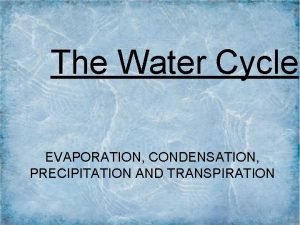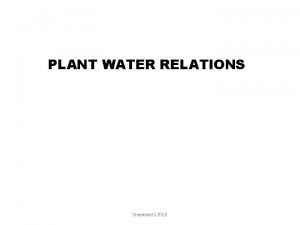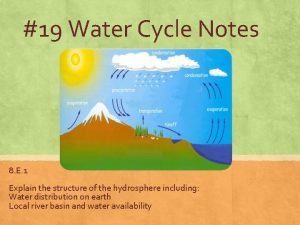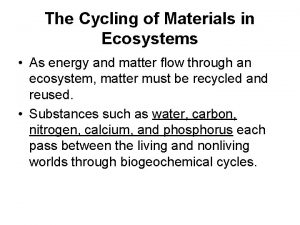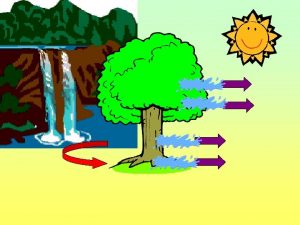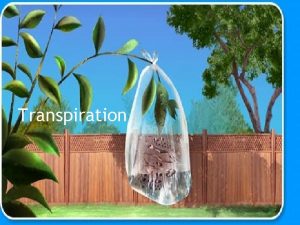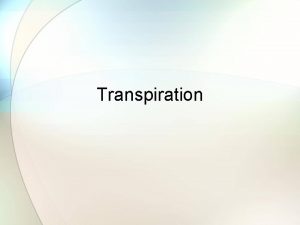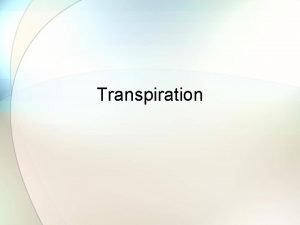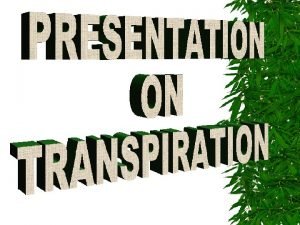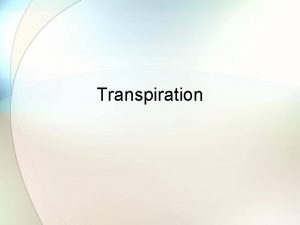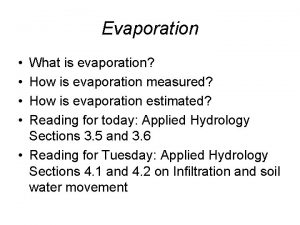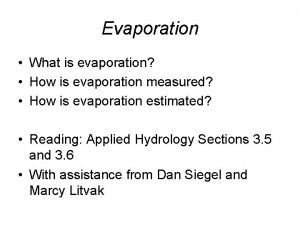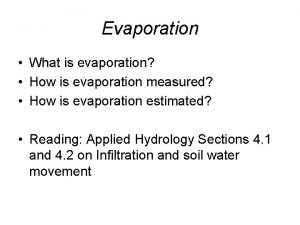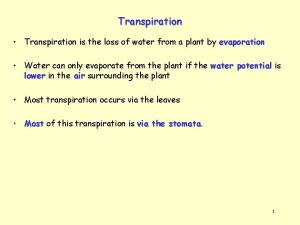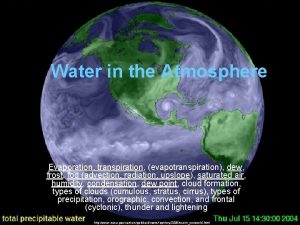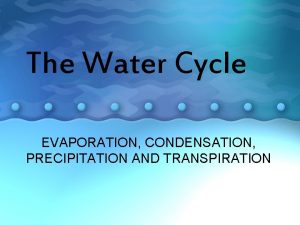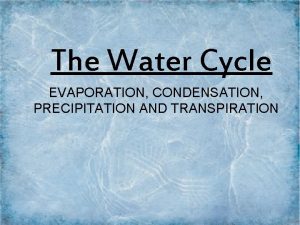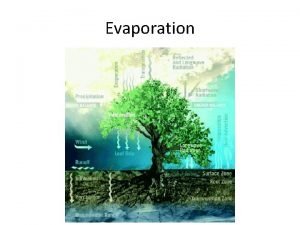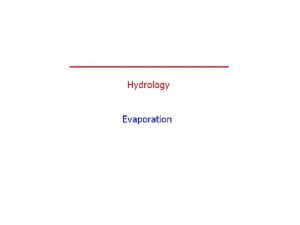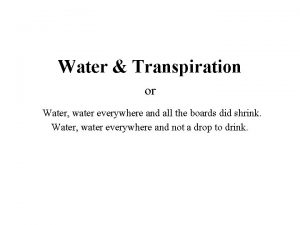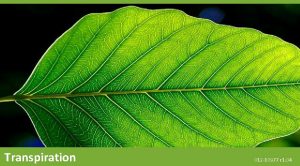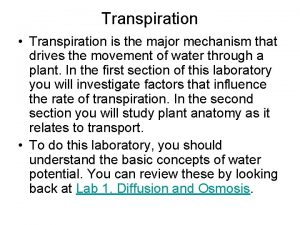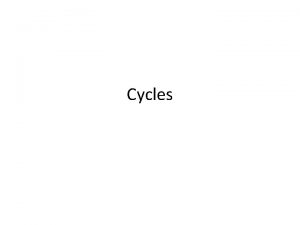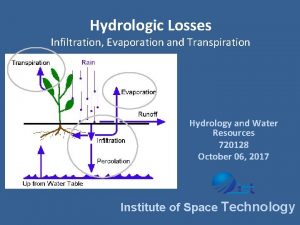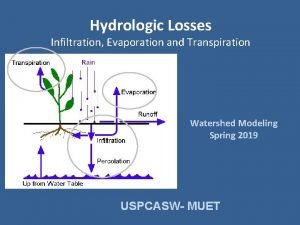TRANSPIRATION Transpiration is the evaporation of water from













![When the stomatum is opening, the [K+] rises to 0. 5 M, anions rise When the stomatum is opening, the [K+] rises to 0. 5 M, anions rise](https://slidetodoc.com/presentation_image_h/25165304b83ae24003d468469ae397ac/image-14.jpg)














- Slides: 28

TRANSPIRATION • Transpiration is the evaporation of water from the aerial parts of plants. Of all the water plant absorbs, over 95 -99% is transpired to the air as water vapor.

From where water is transpired? • Aerial parts of whole young plant • Lenticels (lenticular transpiration) 0. 1% • Cutin (cuticular transpiration) 3%~10% Stomatum (stomatal transpiration) ~ 90% Water normally leaves a plant as vapour, and it is the heat of the sun that provides the energy to cause this evaporation and maintain the flow of water through a plant. Plants can lose large amounts of water through transpiration. A sunflower may lose 1 -2 litres in a day, a large oak tree up to 600 litres in a day.

• Water (H 2 O) Exit of Water Through the Stomata Water evaporates from the air spaces and diffuses through the stomata. Immediately next to the leaf is a layer of stationary air. Water vapour must diffuse through this layer before being swept away by moving air, and the thinner the layer of stationary air the faster the rate of transpiration

Stomatal transpiration Cuticle Prevents water loss Mesophyll Site of photosynthesis Cuticle Stomata Openings allow gases and water to move in and out of leaf Guard cells Open and close the stomata

4. Guard cells: • cells that open and close the stoma 5. Stomata: openings in leaf’s surface; when open: • GAS EXCHANGE: Allows CO 2 in & O 2 out of leaf • TRANSPIRATION: Guard Cells Stomata

Characteristics of guard cells

The guard cells control the opening and closing of the stomata Guard cells flaccid Guard cells turgid Thin outer wall Thick inner wall Stoma closed 7 Stoma open

Guard cell properties and their relationship with stomatal control • Thickness of CW varies in the ventral and dorsal part of the guard cells. In kidney shaped guard cells thick inner and outer walls, a thin dorsal wall (wall in contact with epidermal cells) and a somewhat thickened ventral pore wall • Contains chloroplast and can perform light reaction. (not dark reaction for the lack of key enzymes) • Structurally isolated from epidermal cells for the lack of plasmodesmata (water and ions transmit only through cellular pathway, thus helps to build up water gradient) • Little volume, little amount of water absorption or loss controls stomatal aperture.

Active Potassium Pump Theory: The concept of K+ ion transport was given by Fujino. It was supported and elaborated by Levitt & Rashke in 1975 It appears to be an active mechanism which needs ATP. It is based on recent observations and (explains the mechanism as follows. A. Opening of Stomata during Daytime (in presence of light): Opening of stomata depends upon following conditions: (a) Presence of light. (b) Decrease in starch contents of guard cells. (c) Increased concentration of malic acid in guard cells. (d) Influx of K+ ions in guard cells. (e) Efflux of H+ ions from guard cells. (f) Intake of CI ions by guard cells. (g) Low CO 2 concentration in an around guard cells. (h) High p. H (more than 7) in guard cells (hence, alkaline medium of the cell sap in guard cells). (i) High T. P. in guard cells due to endosmosis, (turgidity of cells). (j) TP more towards thin wall of guard cell & stomata open.

Protons (H+) thus formed are used by the guard cells for the uptake of K+ ions (in exchange for the protons H+). This is an active ionic exchange and requires ATP energy and cytokinin (a plant hormone). In this way, the concentration of K + ions increases in guard cells. At the same time, the concentration of H+ ions decreases in guard cells. The p. H of the cell sap in guard cells also increases simultaneously (p. H becomes more than 7 and the medium becomes alkaline). There is also an increased uptake of CI” (anions) by the guard cells to maintain the electrical and ionic balance inside and outside the guard cells. The malate anions formed in the guard cells are neutralized by the K+ ions. This results in the formation of potassium malate. Malate anions + K+ →Potassium malate: Potassium malate enters the cell sap of the guard cells thereby reducing the water potential while increasing the osmotic concentration (and the O. P. ) of the cell sap. Hence, endosmosis occurs, guard cells become turgid and kidney-shaped and the stomata opens.

It is also observed that the CO 2 concentration is low in and around guard ceils during day time. This is due to high photosynthetic utilization of CO 2. It helps in opening of stomat

Closing of Stomata in Absence of Light (Darkness/Night Time): Closing of stomata depends on following conditions: (a) Absence of light. (b) Decreased concentration of malic acid in guard cells. (c) Efflux of K+ ions from guard cells. (d) Influx of H+ ions in guard cells. (e) Acidic medium of the cell sap in guard cells. (f) Loss of Cl– ions from guard cells. (g) Increases CO 2 concentration in and around guard cell due to release of CO 2 in respiration combined with the absence of photosynthetic activity in dark. (h) Presence of plant growth inhibiting hormone abscissic acid (ABA), (i) Loss of turgidity and loss of kidney-shape by guard cells. All these conditions represent the reversal of the daytime events. Under these conditions, the guard cells lose water by exosmosis and become flaccid. This causes closing of the stomata.

Mechanism of stomatal opening ----K+ absorption theory HCO 3 -+PEP Mal • H+-ATPase in PM is light activated PM Mal- +H+ H+ light H+ V K+ H+ Cl- Its function is out-pumping H+ • Inward rectifier K+ channel is voltage dependent, PM hyperpolarization activates the channel and carry K+ inward • Cl- is transported through Cl- /H+ symport or Cl-/OHantiport
![When the stomatum is opening the K rises to 0 5 M anions rise When the stomatum is opening, the [K+] rises to 0. 5 M, anions rise](https://slidetodoc.com/presentation_image_h/25165304b83ae24003d468469ae397ac/image-14.jpg)
When the stomatum is opening, the [K+] rises to 0. 5 M, anions rise to 0. 2 -0. 5 M, the osmotic potential drops 2 MPa, thus bring water in.

Factors influencing stomatal aperture • • • Light Temp. CO 2 Water content Plant hormone

(1). Light • Stomata of most plant open in the day and close at night, while CAM plants are just the opposite. • Stomata opening are sensitive to red light and blue light, and blue light is more effective, it stimulates opening by a blue-light receptor: zeaxanthin.

(2) Temperature • Stomatal aperture increase with Temp, within 20 - 30℃ (the optimal). (3). CO 2 • Low CO 2 conc. promotes stomatal opening, while high CO 2 conc. inhibits stomatal opening through its acidification of the guard cell thus inhibits PM hyperpolarization. (4) Water content • Stomata open when the leaf contains enough water. When there is a water shortage, they (6) Plant hormones close. • CTK promotes opening • ABA inhibits

Factors that influence transpiration Transpiration from the leaf depends on two major factors: 1. Difference in water vapor gradient 2. Diffusional resistance The driving force of transpiration is the “vapor pressure gradient. ” This is the difference in vapor pressure between the internal spaces in the leaf and the atmosphere around the leaf Diffusional resistance comprises stomatal resistance and boundary layer resistance

Stomatal resistance-resistance associated with the diffusion through stomatal pore Boundary layer resistance- The resistance due to unstirred air next to leaf surface through which water vapour must diffuse to reach the turbulent air of the atmosphere. The thickness of boundary layer is determined by wind speed and leaf size. When air surrounding the leaf is very still , the layer of unstirred air on the leaf surface may be so thick that it is the primary deterrent to water vapour loss Hairs on surface of leaves can serve as microscopic wind breaks

Transpiration flux, g H 2 O/cm 2 leaf surface/second X 10 -7 3. 0 Wind speed influences transpiration 2. 5 The boundary layer around a leaf is thick in still air, and constitutes a major resistance to the flux of H 2 O from the leaf. A slight increase in wind speed will reduce the boundary layer, and increase transpiration. 2. 0 1. 5 1. 0 Further increase in wind speed may reduce transpiration, especially for sunlit leaves, because wind speed will cool the leaf directly 0. 5 Stomatal aperture, m http: //forest. wisc. edu/forestry 415/lecture 6/windspd. htm

Moving Air Removes the Boundary Layer of Water Vapour From the Leaf Still air Saturated air accumulates around leaf Moving air Water vapour is removed from the leaf surface cross section through a leaf Lower Boundary layer 21 the gradient is increased, so gradient faster rate of water evaporation via the stomata

Environmental factors that affect the rate of transpiration 1. Light Plants transpire more rapidly in the light than in the dark. This is largely because light stimulates the opening of the stomata , Light also speeds up transpiration by warming the leaf. 2. Temperature Plants transpire more rapidly at higher temperatures because water evaporates more rapidly as the temperature rises. Transpiration rates may double with an increase from 68 degrees F to 86 degrees F. 3. Humidity When the surrounding air is dry, diffusion of water out of the leaf goes on more rapidly.

• 4. Wind When a breeze is present, the humid air is carried away and replaced by drier air. • 5. Soil water A plant cannot continue to transpire rapidly if its water loss is not made up by replacement from the soil. When absorption of water by the roots fails to keep up with the rate of transpiration, loss of turgor occurs, and the stomata close. This immediately reduces the rate of transpiration. If the loss of turgor extends to the rest of the leaf and stem, the plant wilts. Closing of the stomata will end photosynthesis due to a lack of carbon dioxide entering the plant. This slows the plant’s metabolism

aquatic plants Fringed Water-lily Stomata are found only on the upper epidermis because the lower epidermis is submerged in water. If the stomata were to be on the underside, they wouldn't be able to perform their function (i. e to allow water to evaporate and thus contribute to transpiration).

Intrinsic Factors Affecting the Rate of Transpiration. 1. Leaf surface area 2. Thickness of epidermis and cuticle 3. Stomatal frequency 4. Stomatal size 5. Stomatal position 25

Movement of Water Through the Stomata H 2 O Diffusion shells 26 Water moves from a higher (less negative) to a lower (more negative) water potential

Increase in stomatal frequency increases the rate of transpiration Boundary layer stoma If the distance between the stomata is less than 10 X the pore diameter the diffusion shells overlap So increasing the number of stomata per unit area will have no further effect on transpiration 27

Antitranspirants are compounds applied to the leaves of plants to reduce transpiration. They are used on Christmas trees, on cut flowers, on newly transplanted shrubs, and in other applications to preserve and protect plants from drying out too quickly. Antitranspirants are of two types: Metabolic inhibitors These reduce the stomatal opening and increase the leaf resistance to water vapour diffusion without affecting carbon dioxide uptake. Examples include phenylmercuric acetate, abscisic acid (ABA), and aspirin. Film-forming antitranspirants These form a colorless film on the leaf surface that allows diffusion of gases but not of water vapour. Examples include silicone oil and waxes.
 Transpiration is the evaporation of water from
Transpiration is the evaporation of water from Transpiration
Transpiration Water and water and water water
Water and water and water water Water molecule evaporation
Water molecule evaporation Evaporation water cycle
Evaporation water cycle Water potential in transpiration
Water potential in transpiration Transpiration water cycle
Transpiration water cycle The cycling of materials
The cycling of materials Chó sói
Chó sói Thẻ vin
Thẻ vin Thể thơ truyền thống
Thể thơ truyền thống Các châu lục và đại dương trên thế giới
Các châu lục và đại dương trên thế giới Từ ngữ thể hiện lòng nhân hậu
Từ ngữ thể hiện lòng nhân hậu Diễn thế sinh thái là
Diễn thế sinh thái là Lp html
Lp html Ví dụ giọng cùng tên
Ví dụ giọng cùng tên Vẽ hình chiếu vuông góc của vật thể sau
Vẽ hình chiếu vuông góc của vật thể sau Phép trừ bù
Phép trừ bù Khi nào hổ con có thể sống độc lập
Khi nào hổ con có thể sống độc lập Lời thề hippocrates
Lời thề hippocrates Thang điểm glasgow
Thang điểm glasgow đại từ thay thế
đại từ thay thế Quá trình desamine hóa có thể tạo ra
Quá trình desamine hóa có thể tạo ra Công thức tính độ biến thiên đông lượng
Công thức tính độ biến thiên đông lượng Thế nào là mạng điện lắp đặt kiểu nổi
Thế nào là mạng điện lắp đặt kiểu nổi Dạng đột biến một nhiễm là
Dạng đột biến một nhiễm là Bổ thể
Bổ thể Vẽ hình chiếu đứng bằng cạnh của vật thể
Vẽ hình chiếu đứng bằng cạnh của vật thể Nguyên nhân của sự mỏi cơ sinh 8
Nguyên nhân của sự mỏi cơ sinh 8

